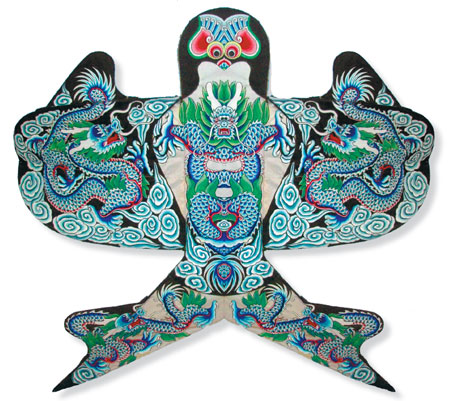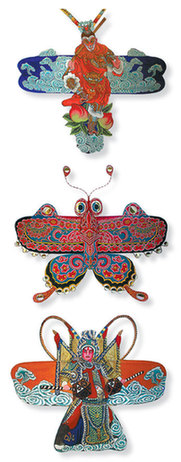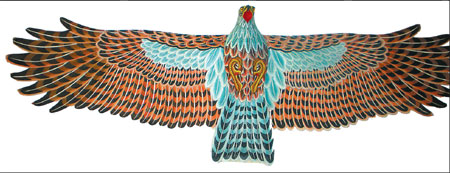High Flyers
Updated: 2012-07-22 08:25
By Chitraleka Basu (China Daily)
|
|||||||||||

 |
Kite-flying can be a consuming passion as Chitraleka Basu finds out at the Weifang International Kite Festival, which had attracted an ardent gathering of international hobbyists.
It was a bit of a surprise to find Qian Jianguo on stage at the ceremony of the 28th Weifang International Kite Festival early this year. Qian, a diminutive man of 68, performed his own little act, twirling and gliding on stage, imitating the motions of his modest eagle-shaped kite - a self-designed contraption that can fly even without wind to keep it afloat. We had met him earlier in the day, and he never gave a hint that he would be a star turn among the musical celebrities with huge fan bases in the audience.
His self-effacing attitude, we found, was endemic among most Weifang residents. They let the kite take center-stage and build their lives around it.
Take Tang Ang, for instance, whom we met at the Weifang Fuyanshan International Kite-flying Ground, minutes into the first day of the festival.
Standing underneath a glowing morning sky crisscrossed by whizzing kites of all shapes - centipede dragons, long-tailed phoenixes, angular stunt kites, even a motorcycle - Tang tells us about his strong attachment to kites.
He had quit a good job with a phone-parts manufacturing company and taught himself to speak English so he could be a better advocate for Weifang kites beyond Chinese shores. Tang, in his 30s, now works as a sales manager with a kite-manufacturing company that supplies its products to Houston in the US state of Texas.
"Weifang, as you know, is the kite capital of the world, and being a Weifang native, I wanted to be a part of its kite culture," he says.
Qian Jianguo was a late entrant to this culture. He took up the craft after retiring from a factory in 2005 - "hoping to add a bit of color to my life" - and learned it by keenly watching others. Now, of course, it's the only life he knows.
"I find it's a great way to make friends across the world through flying kites. I feel I am working as a cultural ambassador for the country, helping foreign friends to know about Chinese culture," he says.
The Malaysian kite festival held at Johor Bahru in February 2012 was a high point in his career.
"There was no wind and mine was the only kite that could take off. All cameras were trained on me."
It took Qian about three years to develop that special technique, but it was worth the effort. "At that moment, I felt like a kite myself, soaring in the sky."
This being the Year of the Dragon, according to the Chinese zodiac, the mythical beast was a hands-down favorite at the festival, in which 110 teams from 67 countries participated.
They brought kites of every size - from 20 to 600 meters. While most were designed after the traditional centipede dragon model - which is generic to Weifang - there was at least one that did not show the dragon at all, but suggested its presence.
Based on the theme of Weifang's economic development, the kite, presented by the Weifang Kite Committee, was a giant rose-pink open-ended box, on which blue clouds and waves were painted.
"It's a symbol of the dragon who lives in the seas," says team leader Liu Ziqing. "We would like to see China touch the heights of development, fly up into the skies like a dragon."
Sun Zhanfu, who has been a Weifang kite festival regular since its inception in 1984, brought his own hand-crafted dragon, more than 200 meters long. "Making kites is great fun," he tells us. He has more than 10 apprentices to whom he has been teaching the art of making a traditional Weifang kite.
"Weifang kite-making technique has been listed among the national intangible cultural heritages," he says, visibly pleased with his role in passing on the time-tested craft to younger generations.
Some people were more focused on winning.
Zhong Jian's dragon lay all taut and sprawled on the ground. He was waiting for a stronger wind to pull it up. "But once it does, I'll easily win the competition," he tells us. "And even if I don't, I'll compete again next year."
Meanwhile, a giant parachute-shaped soft kite in rainbow colors that a crowd of people had been trying to fly for a while, lifted a few meters off the ground only to drop again, sweeping across the ground.
Spectators scurried to get out of its way, not wanting to get caught in the maze of a 100 strings attached to it. Those in the fore of the army of 40-odd people trying to hoist it up fell and rolled a few meters out of the way.
A stunt kite team from Taiyuan in Shanxi province pulled off an awesome feat. Manipulated by four team members, four kites twisted and twirled, rolled and dove into the air, to the tune of lively songs.
The kite runners skipped backwards and bent over, touching the ground almost, as if dancing in sync with the kites they flew.
"I fell in love with kite ballet when I first saw a video on a foreign website about 20 years ago. Few Chinese kite flyers were into the sport at that time," says Niu Yongjun, their leader.
"An American kite team brought stunt kites to the Weifang kite festival in 2009. They helped us buy a set and taught us the basics. When the wind is below 10 kilometer per hour, we select slow movements. It seems you can do anything with your kite. I just love the feeling."
Dan Tonio of San Diego, California, was busy fixing a four-line stunt kite. He runs what he calls the last American kite manufacturing company. Dan was in Weifang not to compete or pursue business interests, but for the pure joy of "hanging out with friends from all across the world".
But how much longer could this ancient sport possibly hold out against the tide of more modern forms of entertainment and shrinking attention spans?
"You can only hope that events like these might help take the cause forward, but there's no guarantee that might actually happen," says Tonio.
One of Weifang's major lures, we realized, was the prospect of meeting old friends and making new ones. As Muammar Quaddafi, a Malaysian who runs the Borneo International Kite Festival, says, "It is about building relationships through kites. The kite-flying fraternity is like one big happy family, cutting across cultures."
And while Weifang as the host city was the seat of many such reunions, it was also, as participant Wang Jiahua says, "an opportunity to develop local economy and for Weifang culture to go out into the world".
Cui Yongli, a Qingdao native and a Weifang festival veteran who has made winning a habit during the past 20 years, has attended several festivals abroad.

"Weifang is mounted on a far larger scale," he says of the annual April festival. "Here you get to see a lot more in terms of people and kites."
His own offering is a case in point. From enormous geometric tiered kites, to the regulation centipede dragon to traditional kites with floral images - one could find every sort under his huge tent. For a while he held the record for the longest snake-shaped kite, measuring slightly more than 882 meters.
"The kite is not just an industry in Weifang but a medium that could make the city earn its place in the world," says Liu Ziqing.
Which is not to discount the value of local pride. At 7, Liu Yixuan is already a seasoned festival-goer, having been here in three past seasons. He pointed gleefully to an enormous soft kite with hedgehog spikes and fuchsia colors, switching allegiance the next moment to a slow-rising motorbike-shaped kite that caught his eye.
"I am definitely going to tell my classmates about the flight of these enormous kites at school tomorrow," he says.
Wang Qian contributed to this story. Contact the writers at sundayed@chinadaily.com.cn.
Today's Top News
Rescuers race against time for quake victims
Telecom workers restore links
Coal mine blast kills 18 in Jilin
Intl scholarship puts China on the map
More bird flu patients discharged
Gold loses sheen, but still a safe bet
US 'turns blind eye to human rights'
Telecom workers restore links
Hot Topics
Lunar probe , China growth forecasts, Emission rules get tougher, China seen through 'colored lens', International board,
Editor's Picks

|

|

|

|

|

|





